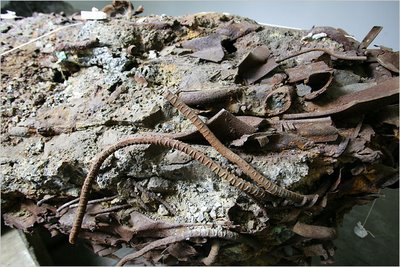いらっしゃい! 日本語か英語で一節を書いて、ほかの言語に訳します。(それはタイトルのいう意味です。) 特別なテーマがなく多い論題について書きますから、コメントを書こうと決心すれば、遠慮なく何かについてお書きになってください。しかも英語か日本語を勉強していたら、何でも質問してください。そして私が日本語で書くことには間違いがあったら、指摘してくれてください。
23.11.06
20.11.06
あなたは何でしょうか?
The ORIGINAL Internet Political Quiz
Take the Quiz now and find out where you fit on the political map!
Aは賛成
Mは若しかする
Dは不賛成
| Personal Issues | |||
| (Choose A if you agree, M for Maybe, D if you disagree.) | A | M | D |
| Government should not censor speech, press, media or Internet |
|
|
|
| Military service should be voluntary. There should be no draft |
|
|
|
| There should be no laws regarding sex for consenting adults |
|
|
|
| Repeal laws prohibiting adult possession and use of drugs |
|
|
|
| There should be no National ID card |
|
|
|
- 治国は言葉とプレスとメディアとインターネットを譴責しないほうがいい。
- 軍役は随意でいい。徴兵がなければいい。
- 得心する大人の性行動について法則がないでいい。
- 薬物不法所持と薬物使用を禁じる法則を撤回する。
- 国民的なアイディーカードがあらないでいい。
| Economic Issues | |||
| (Choose A if you agree, M for Maybe, D if you disagree.) | A | M | D |
| End "corporate welfare." No government handouts to business |
|
|
|
| End government barriers to international free trade |
|
|
|
| Let people control their own retirement; privatize Social Security |
|
|
|
| Replace government welfare with private charity |
|
|
|
| Cut taxes and government spending by 50% or more |
|
|
|
上記の質問:
- 企業の福利を止める。治国から用務にハンドアウトはだめ。
- 治国のインターの自由貿易障壁を止める。
- 人々の退任を束ねるのを許す・社会保障の民営化を許す
- 治国の福利を私的な施しに換える
- 治国の費消と租税を五十パーセント(以上)に縮める
I took this test, and here is my score:
このテストを取って、これは私のスコアです:
ACCORDING TO YOUR ANSWERS,
The political description that
fits you best is...
.
LIBERTARIAN
LIBERTARIANS support maximum liberty in both personal and
economic matters. They advocate a much smaller government; one
that is limited to protecting individuals from coercion and violence.
Libertarians tend to embrace individual responsibility, oppose
government bureaucracy and taxes, promote private charity, tolerate
diverse lifestyles, support the free market, and defend civil liberties.
The RED DOT on the Chart shows where you fit on the political map.
Your ECONOMIC issues Score is 80%.
あなたは何点ですか?
http://www.self-gov.org/quiz.html
Image & content not by me
私のイメージと内容ではない
17.11.06
A European Government WITH A PAIR
Dutch government says it plans to ban burqa
Cabinet says ban sought on security grounds; Netherlands has 1M Muslims
THE HAGUE, Netherlands - The Dutch government, facing re-election, said Friday it plans to draw up legislation "as soon as possible" banning burqas and other clothing that covers a person's entire face in public places.
"The Cabinet finds it undesirable that face-covering clothing -- including the burqa -- is worn in public places for reasons of public order, security and protection of citizens," Immigration Minister Rita Verdonk said in a statement.
Basing the order on security concerns apparently was intended to respond to warnings that outlawing clothing like the burqa, worn by some Muslim women, could violate the constitutional guarantee against religious discrimination.
In the past, a majority of the Dutch parliament has said it would approve a ban on burqas, but opinion polls in advance of national elections next Wednesday suggested a shift to the left, and it is unclear if a majority in the new parliament would still back the ban.Once the Cabinet drafts a bill, it is sent to the 150-member legislature for enactment.
The main Dutch Muslim organization CMO has been critical of any possible ban. The idea was "an overreaction to a very marginal problem" because hardly any Dutch women wear burqas anyway, said Ayhan Tonca of the CMO. "It's just ridiculous."
Around 1 million Muslims live in the Netherlands, about 6 percent of the 16 million population, but only a few hundred are believed to regularly wear a burqa.
After France banned the wearing of headscarves in public schools, the Dutch government decided to leave that question up to individual schools. Most allow headscarves.
The city of Utrecht has cut some welfare benefits to unemployed women who insist on wearing burqas to job interviews. The city claimed the women were using the burqa to avoid working, since they knew they wouldn't be hired.
http://www.msnbc.msn.com/id/15766750/#storyContinued
前記の書いた事は基本的にオランダの治国がブーカ(burqua/burka)と他の顔を覆う服を禁止する案を立てるつもりです。
I'd like to commend the Dutch. I'm sure people will call this intention racist or religious discrimination, but I have read other articles that show the legislation will be limited towards situation in public where safety or the identification of someone may be or is required. I think an outright ban on burkas would be inappropriate, but I think that Muslims who choose to live in "non-Muslim countries" must be willing to assimilate into that country's culture and allow its government to protect its citizens (which includes the Muslims residing there).
オランダを賞賛します。人々はこの心算をレイシズムとか宗教の被差別と呼ぶんだが、私がこの禁止は応安と同定を要する場合に限るのを示す他の記事を読みました。全きの禁止は不相応だと思いますけど、不イスラム教徒の国に住んでいる回教徒はその国の人文と常民(国に住んでいる回教徒をも含む)が治国に助け守られるのを許すのを遣る気があらなきゃいけない。
News article not by me
私の社説ではない
15.11.06
Life-To-Do-List
- Earn Undergraduate Degree (in progress)
- Earn Masters/Doctorate degree
- Become Financially Independent
- Get Married
- Never get Divorced
- Become Fluent in at least one foreign language (in progress: Japanese)
- Visit Japan (planning)
- Live in a foreign country for a specified/indefinite time period greater than or equal to 1 year (probably Japan)
- Be my own boss -or- work in a "high position" in a company/Dr. Office
- Visit one or more war memorials on foreign soil
- Watch "The Changing of The Guards" at the tomb of the unknown soldier in Arlington National Cemetery
- Raise at least 2 children (in progress)
- Plan and build a home...and help build it
- Hike the Appalachian Trail
- Fire a Machine Gun
- Learn how to hunt
- Be ready for retirement ahead of schedule
- Visit the lands of my ancestors
- Lean enough about something to be able to write a book about it
- Get in shape (in progress)
- Stay in shape
- Be a part in revolutionizing the health care industry towards preventative rather than reactionary medicine (in progress)
- Own a motorcycle
- Design & build or have a 6 output guitar built
- Fly an airplane (takeoff, cruise, and land)
- Start a family tradition
- Witness the Aurora Borealis
- 学位を設ける (進み中)
- 修士号、博士号、医学博士号を設ける
- 財政の自主になる
- 夫婦の縁を結ぶ
- いつまでも縁を切らない
- 最小の一つの外国語をぺらぺらに習う (進み中)
- 日本へ旅行 (目論み中)
- 一定か未定義の時間(最小の一年間)外国に住む (多分日本)
- 私を使えるか身分の高い人で会社か医院に働く
- 最小の一度、外国で戦争追悼を訪れる
- アリングトン国民的な名装置に未詳な軍人の墳墓で「警備員を差し替えり」を見る
- 子供を最少の二人育てる (進み中)
- 家を設計して建てて…構造に助力する
- アパラチアの小道ハイキングする
- 機銃を発する
- 狩ることを習い覚える
- 早目に隠居になることは出来上がる
- 先人の出身を訪ふ
- 本を書くことをできるほど何かを学ぶ
- 体調を整える (進み中)
- いい体調を保つ
- 反動的より医療制度は予防医学に大変革をもたらすことの役割演じる (進み中)
- オートバイを所有
- 六・出力端子のギターを設計して作る
- 飛行機を操縦 (離陸、巡航、着陸)
- 家風を始める
- 北極光の実見
13.11.06
30.10.06
スターフライ・カフェ

今日スターフライ・カフェと言うレストランで晩御飯を食べました。 メニューは大抵アジアンとタイの料理で寿司です。代は凄く高くなかったけど安いわけじゃないんです。中規模ぐらいだと思う。配色はあんまり明色じゃなかっ たから、ゆっくり食べたり飲んだりするのは、胸糞が悪くなかった。それで、しっとりとジャズを架けていて、雰囲気はいいでした。接客態度は立派じゃなかっ たけど、大丈夫でした。無線インターネット接続はサービスだから、ラップトップを使えるんですが、差込が少なかった。注文したものは、私には、ちょっと甘 すぎたから、全部食べられなかった。そうだのに、美味しかった。帰結:あそこでまた食べに行きます。
I ate dinner at a restaurant called the Stirfry Cafe today. The menu was mostly Asian and Tai food plus sushi. The prices weren't very high, but they weren’t cheep either, so I'd say it is probably a mid-range restaurant. The color scheme wasn't very bright, so it wasn't annoying to sit there for a while. Also, jazz was quietly playing in the background. The atmosphere was nice. The service wasn't exquisite, but it was alright. There was free internet access, so you can use your laptop, but there aren’t many electrical outlets. What I ordered was a little too sweet, so I couldn’t eat all of it. Even though it was a little sweet, it was good. Conclusion: I'd go back there again to eat.
11.10.06
Comming Full Circle
Last year I wrote a paper about the possiblity of Japan reforming its constitution to allow for a traditional military. With the events in North Korea the last couple days, I thought it may be appropriate to post that paper.
去年日本の軍隊化の可能性のために憲法を改正についてレポートを書きました。北朝鮮の近事から、そのレポートを貼り出そうと思っていた。
Michael R. Zerby
Political Science 454
Professor Zhong
Coming
Over the last century,
Aspiring sincerely to an international peace based on justice and order, the Japanese people forever renounce war as a sovereign right of the nation and the threat or use of force as means of settling international disputes. 2) In order to accomplish the aim of the preceding paragraph, land, sea, and air forces, as well as other war potential, will never be maintained. The right of belligerency of the state will not be recognized.[3]
From then until the present,
Today
In addition to the JSDF,
Debates over constitutional revision occurred fifty years ago around the time the LDP was created.[7] Revising the Constitution “…has been a long-standing basic idea of the LDP,” Prime Minister Koizumi told reporters.[8] However, revising the Constitution has not been a constant central theme in Japanese politics over the last fifty years. After the debates in the early years of the LDP with the exception of some constitutional challenges to the SDF and US-Japan Security Treaties, revision of the Constitution receded somewhat from public debate until recently.
Koizumi and the LDP’s revisions to the Constitution, if endorsed by the Diet and passed in a nationwide referendum, would alter several areas of the Constitution; of the revisions proposed by the LDP however, the revision to Article 9 will be the most significant amendment affecting the status of Japan as a world military power and the greater role Japan would be able to play in protecting its own national interests militarily. The proposed alteration leaves the first clause of Article 9 as written in the 1947 Constitution, but it changes the second clause of the Article.[9] The provision of Article 9 which states “land, sea, and air forces, as well as other war potential, will never be maintained,”[10] will be removed.[11]
The deletion of that provision would change the status of the JSDF from a defensive force to that of a traditional military. That being said, it is important to note that the war renouncing aspects of the Japanese Constitution are left intact. This suggests that Article 9 under the proposed revision would allow the right to collective self-defense,[12] or coming to the military aid of an ally. However since the first clause of Article 9 is left intact, it would suggest that the ability of
The process by which the LDP would amend the Constitution is specified in Article 96 of the Constitution. First, the proposed amendment would have to be initiated in the Diet. In order to pass, the amendment would have to secure a positive vote of two thirds in both the upper and lower houses of the Diet. If passed, the amendment would have to secure a positive simple majority vote in a national referendum. If both votes are successful, the proposed amendment would be promulgated by the Emperor to become an integral part of the Constitution.[13]
There are several reasons why the LDP would choose this point in Japanese history following World War II to propose amending the Constitution. Generally, these reasons fall into three categories. First is the ability the LDP has to pass amendments to the Constitution. Next is the increasing ambiguity of the difference between the status of the Japanese Self-Defense Forces and a traditional military. The final group is the effects of the Japanese Supreme Court decisions on the constitutionality of the JSDF and the US-Japan Security Treaties.
The LDP has been, with the exception of a few years in the mid 1990s, the major party in Japanese politics. With the recent election this past September, the LDP has won a majority in the House of Representatives holding 61% of the seats;[14] and in the House of Councilors, the LDP won 47% of the seats.[15] This is not enough control of either house, although very close in the House of Representatives, to pass a proposed change to the Constitution. However, the Democratic Party of Japan (DPJ) President Seiji Maehara has voiced support of the revision of Article 9 of the Constitution.[16] Both the LDP and the DPJ together constitute 85% of the House of Representatives and 80% of the House of Councilors.[17] If both parties were to agree on a proposed amendment to the Constitution, they would only need to retain on average approximately 81% of the votes of both parties’ members in both houses to pass an amendment.
Assuming the amendment was to pass both houses of the Diet, a simple majority referendum would be needed to secure the revision of the Constitution. Newspaper polls have shown that about half of the population supported changing the pacifist provision of the Constitution.[18] Even though this does not show overwhelming support for the LDP, it does not show overwhelming opposition to the revision of the Constitution either. However, this is not necessarily showing a fifty-fifty chance of the success or failure of a national referendum. Recently, public support for the constitutional amendment has increased as
Besides recent troop deployments and the growth of the JSDF, there is an additional reason why the Japanese population would be more receptive toward revision of Article 9. In 1998,
Ever since the 1947 Constitution was adopted, the self-defense forces of
Particularly in politics and government, major change is very difficult. However if progress is made in small increments of change towards the desired result, it may be possible that reality becomes so close to that desired result that changing the new altered reality to what once would have been a major undertaking is now arguably justifiable.
The progression of the JSDF, as it becomes and acts increasingly like a military and less as a strictly defending force, has had an impact of the public perception of the JSDF to the effect that the likelihood of a referendum passing has increased. Regardless of weather the maturation of the JSDF over the last fifty years was intentionally done for the purpose of creating ambiguity in regard to the JSDF having a militaristic identity or not, the justification today of labeling the JSDF a military force rather than a defense force can be reached with decreasing effort.
The Supreme Court is the court of last resort with power to determine the constitutionality of any law, order, regulation or official act.[25] Since 1947,
What the rulings of the courts have effectively done is defer the issue to the Diet and Cabinet. Without a specific Supreme Court decision, the authority to interpret Article 9 of the Constitution has been assumed by the Cabinet Legislation Bureau (CLB). The CLB has interpreted Article 9 to mean that the Self-Defense Forces and U.S.-Japan Security Treaties are acceptable and not unconstitutional. This interpretation has allowed
As stated previously, the increase of military action, enabled by the absence of definitive decisions by the Supreme Court, has been a factor in the rising public support for amending the Constitution including the second clause of Article 9. As public opinion sways more in favor of amending the Constitution, Diet members may feel more pressure to satisfy their constituency. This may particularly be the case of the DPJ and the LDP which both having already expressed interest in amending the Constitution.
The rulings of the Supreme Court giving way to the interpretation of Article 9 by the CLB, the increasing ambiguity of the militaristic status of the JSDF along with poor foreign relations with some of Japan’s regional neighbors, and the ability of the LDP to push an amendment through the Diet and secure a positive simple majority in a national referendum all have their own particular effects on the likelihood of the remilitarization of Japan. In addition, all three major areas of influence on the likelihood of the remilitarization of Japan also have an indirect effect on the likelihood of remilitarization at the same time as they influence each other.
If these influences and the interactions between them give way to a revised Japanese Constitution allowing the maintenance of war potential, it would signify the final step of
[1] “Timeline:
[2] Treaty of
[3] The Constitution of
[4] John O. Haley, “Waging War:
*“Waging War:
**The page number corresponds to the page of draft.
[5] Reference.com: http://www.reference.com/wiki/Japan_Self-Defense_Forces
[6] Reference.com: http://www.reference.com/wiki/Japan_Self-Defense_Forces
[7] “EDITORIAL/Constitutional revision: The LDP apparently put off debate on Article 9”, The Asahi Shimbun, http://www.asahi.com/english/Herald-asahi/TKY200510310093.html
[8] “LDP finalizes draft for revising Constitution”, Japan Today, http://www.japantoday.com/e/?content=news&cat=9&id=353595
[9] “
[10] The Constitution of
[11] “LDP finalizes draft for revising Constitution”, Japan Today, http://www.japantoday.com/e/?content=news&cat=9&id=353595
[12] “EDITORIAL/Constitutional revision: The LDP apparently put off debate on Article 9”, The Asahi Shimbun, http://www.asahi.com/english/Herald-asahi/TKY200510310093.html
[13] The Constitution of
[14] Japan, National Diet of Japan, House of Representatives, Strength of the Political Groups in the House of Representatives, http://www.shugiin.go.jp/index.nsf/html/index_e_strength.htm
[15] Japan, National Diet of Japan, House of Councilors, List of the Political Groups in the House of Councilors, http://www.sangiin.go.jp/eng/member/index.htm
[16] “Maehara backs changing war-renouncing Article 9”, The Japan Times, http://www.japantimes.co.jp/cgi-bin/makeprfy.p15?nn20051018a6.htm
[17] “Toward a new Constitution”, The Japan Times, http://www.japantimes.co.jp/cgi-bin/makeprfy.p15?eo20051017kn.htm
[18] “
[19] “
[20] New role envisioned for military in
[21] John O. Haley, “Waging War:
*see footnote on pg. 2.
**see footnote on pg. 2.
[22] Reference.com, http://www.reference.com/wiki/Japan_Self-Defense_Forces
[23] John O. Haley, “Waging War:
*see footnote on pg. 2.
**see footnote on pg. 2.
[24] Reference.com, http://www.reference.com/wiki/Japan_Self-Defense_Forces
[25] The Constitution of
[26] John O. Haley, “Waging War:
*see footnote on pg. 2.
**see footnote on pg. 2.
[27] John O. Haley, “Waging War:
*see footnote on pg. 2.
**see footnote on pg. 2.
[28] John O. Haley, “Waging War:
*see footnote on pg. 2.
**see footnote on pg. 2.
7.10.06
カタカナ語の言論
安倍首相:カタカナ言葉は109回 小泉首相の4倍
安倍晋三首相の所信表明演説は政策面でカタカナ言葉が目立つ。「オープンな経済社会」に「イノベーション(技術革新)の創造」と明記するように、具体的な 数値目標の代わりにカタカナ言葉を多用することで、斬新なイメージをアピールする狙いもありそうだ。しかし「美しい国、日本」を掲げ、伝統や歴史を重視す る保守色の濃い内容に比べると、ちぐはぐな印象も否めない。
所信表明は全体で8301字。自民党総裁選で訴えた政権構想の内容を網羅的に盛り込んだ結果、就任後初の演説としては森喜朗元首相の4982字、小泉純一郎前首相の6452字より長い。
この中でカタカナ言葉は、ミサイルやテロなど日本語に置き換えにくいものや、国の名前などの固有名詞を含めると、延べ109回も登場。カタカナや役所言葉を嫌った小泉前首相の就任時演説に比べ約4倍の分量だ。
例を挙げると「自宅での仕事を可能にするテレワーク」や「日本がアジアと世界の架け橋となる『アジア・ゲートウェイ構想』の推進」「未来に向けた新しい日本の『カントリー・アイデンティティー』」といった具合。
聞いただけではピンとこないものも多く、多用の効果には疑問符も付きそうだ。【鬼木浩文】
毎日新聞 2006年9月29日 13時38分
Abe's katakana-laden policy speech rings hollow with listeners
New Prime Minister Shinzo Abe's use of words written in katakana, a form of writing used mainly for scientific terms and words derived from other languages, stood out in his policy speech on Friday, as he apparently aimed to create a new image of himself as a leader.
Abe, at 52 the youngest Japanese prime minister in the post-war period, used a total of 109 katakana words in his speech, four times the number used by former Prime Minister Junichiro Koizumi, who disliked katakana words and bureaucratese.
The prime minister is apparently trying to send out a new image with his use of fuzzy katakana words instead of concrete target figures. However, at the same time he is promoting the slogan "Beautiful country,
Abe's policy speech, which provided comprehensive details on the administration he promoted during the election for presidency of the ruling Liberal Democratic Party, was 8,301 characters long. For an inaugural speech, it was longer than the 4,982-character speech given by former Prime Minister Yoshiro Mori and the 6,452-character speech by Koizumi.
The katakana terms Abe used included words such as "missairu" (missile), and "tero" (terrorism), which are hard to convert into Japanese, as well as with names of foreign countries and other proper nouns.
Other examples in phrases from Abe's speech included "terewaaku (telework) enabling work to be done from home," "the promotion of an Ajia geetouei (Asian gateway) concept with which
Many of the words failed to strike a chord among listeners and doubts appear to remain over whether using so many katakana words is actually effective. (Mainichi)
最初の数クラスを取っていた 同級生から聞いた事は、その学生達が、覚えにくかったと思ったから、カタカナ言葉が嫌いだった。その時に私はそうと思っていなかったが、日本語の学習が進 化する間、出来るだけ少ないカタカナ言葉を使うようにするようになった。それは使うカタカナ言葉の数があげると、愈々日本語じゃないそうになるからです。 許りでなく外来語じゃない言葉のほうが気概があるそうと思う。
皆どうと思う?同ずる、異なる?コメントを書いてください。
From what I have herd from my classmates in the first few Japanese classes were that they disliked katakana words because they thought that the characters were difficult to remember. I did not think so at the time, but as I progressed in learning Japanese I began to prefer to use as little katakana words as I could. That is because I think that the more katakana words that are used, the less and less like Japanese a person's language becomes. Not only that, but non-borrowed words seem to have a stronger spirit contained within them.
What does everyone think? Do you agree or disagree? Please leave a comment!
6.10.06
切り変えなければいけない人は、私。
Sometimes when I've been dumped or when life seems a little lonely, I talk with my mom. Somewhere along those conversations, my mom usually says something like, "There is someone out there for you, but either you or her isn't ready, and maybe has to change. Because of that God hasn't allowed you two to meet." At those times I would say things like, "Yeah, you're probably right," and "I hope she would hurry up and change." However, today I changed my mind. It isn't her who needs changing, its me. Since a few years ago I had become lazy. I allowed things like household chores to be put off because I was always thinking there was urgent business to attend to. And also, I wasn't able to do the things that I wanted to do because I had constructed imaginary barriers. I have been too lax with myself. From here, I am going to act a bit differently and passionately do my best.
22.9.06
Rich Mountain Loop
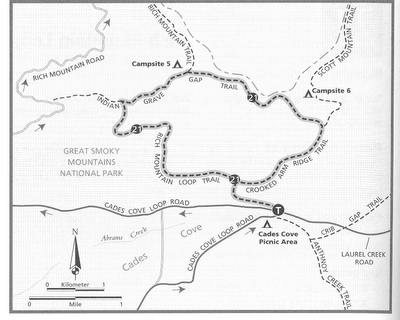
私のイメージではない
この書き込みは今年の夏の始まりに短いハイクのことです。多く写真を撮りましたが、その写真の中で悪いのが数々でした。それは使っていたカメラが古くなって来ているからで、使い古して始めるのです。以下はいい写真の中から選抜です。
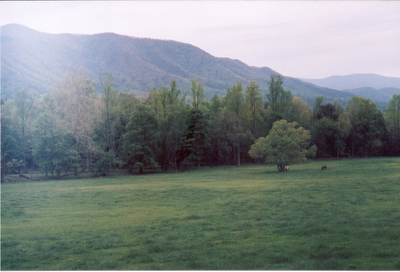
Looking South across the cove.
南にコーヴの向こうを見る。

Redneck Guided Tours: Many people ride on chairs in the back of trucks along Cades Cove Loop Road.
レッドネックに導かれる観光旅行(笑):ケーデゥズ・コーヴ・ループ・ロードをトラックの後ろにあるチェアに座って乗る人が大勢。

Looking north through Cades Cove towards the Rich Mountain Loop trailhead
北にケーデゥズ・コーヴの向こうにあるリッチュ・マウントン・ループ・トレールの地方を見る。

A small creek that runs through Rich Mountain Loop Trail
リッチュ・マウントン・ループ・トレールを横に流れる小さいな川。

John Oliver Cabin (Built in 1817/1818) : The cabin of the first white settlers in Cades Cove.
ジョン・オレヴァ・キャビン(1817・1818年に建った):最初にケーデゥズ・コーヴに住んだ白人の開拓者のキャビン。

The point where the trail started to get a little steep.
トレールが険しくして始めた所。

A blooming dogwood.
咲いているアメリカヤマボウシ

The trail is still going up.
トレールがまだ上に行っている。

Some flowers I found growing slightly off the trail that were growing in groups of four.
少なめのトレールに見つけた四つで増している花。

The trail is still going up.
トレールがまだ上に行っている。

Still going up, close to the ridge.
峠から近く、まだ上に行っている。

(Grave Gap Trail) The trail curves to the right. The path to the left leads up to the sumit.
(グレーヴ・ガップ・トレール) トレールは右へ反らす。左にあるパスは山頂の上に通じる。
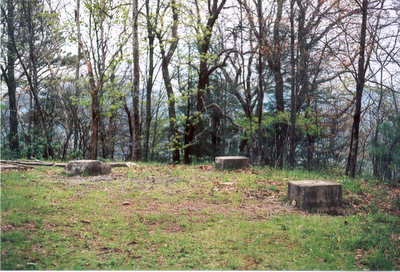
The sumit of Rich Mountain. The foundation in the picture is from an old fire tower.
リッチュ・マウントンの山頂、写真に見える土台は古い火の見からです。
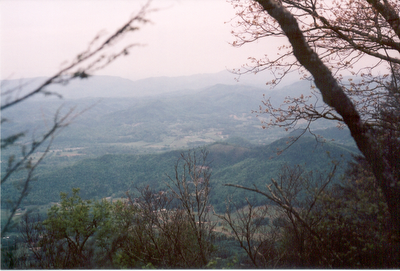
Looking north out of the park on the ridge.
峠から、パークの北の外を見てる。
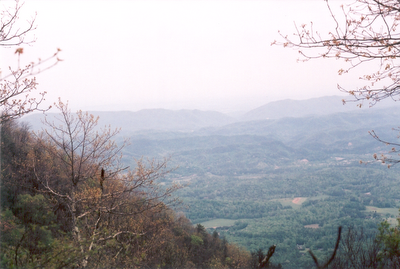
Looking north out of the park on the ridge.
峠から、パークの北の外を見てる。

Looking north out of the park on the ridge.
峠から、パークの北の外を見てる。
12.9.06
アワナ
一ヶ 月ぐらい水曜日に教会でボランティアとして子供の為にアワナという会のスパークスというクラブに働いていました。アワナ会の中にクラブの分野が三つありま す。それらはカビース(プレスクール~幼稚園)とスパークス(幼稚園~小学校三年生)とティ・アンド・ティ[T&T](三年生~六年生)というク ラブがあります。毎週一時間半会って、その一時三十分を三期に分けるんです。一番目の期はスパークル・タイム(ぴかぴかな時間という意味)という期で、こ の時間中子供は本から覚えた聖書の節をそらんじます。若干の子供が一週間十節も覚えられるんですよ。皆すごい!二番目の期はグリーヌ・メドー・タイム(緑 の草地の時間という意味)という期で、この時間中子供たちが聖書とかキリストについて話しかけられます。それからゲーム・タイム(ゲームする時という意 味)です。この時には子供たちを身長の高い順に並べて四つのチームに分けさせるんで、競争して走って騒いで頑張って楽しみます。この週も楽しもう!
For about one month I have been volunteering in the Sparks section of the Awana clubs on Wendsdays at my church. In Awana there are three sections of clubs. Those clubs are the Cubbies (Preschool to Kindergarden), Sparks (Kindergarden through 3rd grade), and T & T (3rd grade through 6th grade). Clubs meet every week for an hour and a half, and that hour and thirty minutes is diveid into three periods. First period is called "Sparkle Time," and during this time kids recite bible verses from their books that they have memorized. Some students recite as many as 10 verses in one week! Wow! The second period is called "Green Meadow Time," and during this time the kids recieve a message about the Bible, Christ, or other things about Christianity. From there it is "Game Time." The kids are lined up according to height and separated into four teams. They compete in a game, run around, make lots of noise, do there best, and have a great time. Let's have a great time this week too!

私のイメージではない
11.9.06
まだ思い出す -- I Still Remember
The Best Fortune Ever!
-- "The greatest danger could be your stupidity."
That is the absolute best fortune I have ever seen!
古今無類のフォーチュン
弟は中華料理屋で食べて、もらったフォーチュンを見せました。 ...これ:
-「最大の危険は あなたの盆暗だかもしれない。」
古今無類の読んだことがあるフォーチュンだ!
10.9.06
Nothingness: Talk to a Stone
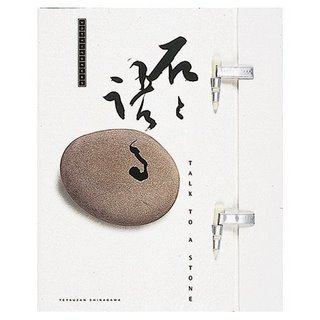
I browsed through the Japanese language and literature section of the library while I was successfully avoiding doing some reading for my history classes. I finally came a cross this book. The book is a compilation of poetry gathered by Tetsuzan Shinagawa and his caligraphy. The first thing that is noticable about the book after it has been opened is that it is writen in Japanese and English. I was origionally looking for a compilation of Japanese poetry so that I could give a try at translating some, but I wasn't able to find exactly what I was looking for. However, since this book is already translated I can try and translate some of them and still be able to enjoy the poems that I would not have been able to translate.
Here are some excerpts from the book that I liked:
首 尾良く歴史のクラスの読み物を躱す間に、図書館で日本文学と日本語の部門を立ち読みしていて、結局この本を通り合わせた。 集めた品川哲山の表意文字と詩 歌の巻です。開けた後で即座に認められることは英語でも日本語でも書きました。初めは訳すようにしてみるために詩集を探していましたが、ちょうど欲しかっ たような本を見つけられなかった、けれどもすっかり翻訳してしまったから、まだ訳すようにできて、翻訳できない詩を楽しめる。
本から好きな数抜粋:
A stone, however large it may be, cannot be enought to build a tall castle.
A man, however great he may be, cannot be a hero by himself.
A tall castle can be so tall because there are foundation stones that remain unknown. A man can be such a great hero because there are many heroes that remain unknown.
Journalist & Historian Tokutomi Soho (1863-1957)
かの一片の石は大なりといえども もっと高城を築くに足らず。
一個の人物は偉大なりといえども もっと英雄となるに足らず。
高城をしてかくのごとく 高からしめたるものは 無名の礎石あればなり。
英雄をして彼かごとく 大ならしめたるものは 無名の英雄あればなり。
徳富蘇峰
Let all the people
Of the world
Say what they please;
I alone know what I do
Tanka by loyalist samurai Sakamoto Ryoma (1835-1867)
世のなかの人は何ともいわばいへ
我がなすことは我のみぞ知る
坂本竜馬
A maple leaf scatters
showing both sides of itself
Haiku by Ryokan (1758-1831)
裏を見せ表も見せて散るみじ
良寛
Someone else is someone else, I am I;
Whatever the case, I take the very road that I take
Tanka by Philosopher Nishida Kitaro (1870-1945)
人は人吾はわれ也
とにかくに吾行く道を我は行なり
西田幾多郎
Love recognizes neither East nor West.
Shinagawa Tetsuzan
愛無東西 あいに とうざいなし
愛は 国境を越えて 生きている
品川哲山
Image not by me
私のイメージではない
9.9.06
強い風
止めぬと思うほど強い
ただもう絶えた
A Strong Wind
Suddenly a strong wind blows
So strong that I think it will never end
But, it has already ceased
Wings
Nearing unconsciously,
I could see your magnificent wings.
Strong enough to carry one around the earth,
And as beautiful as a song sings.
A sight deeply breathed.
And as if it had happened every day,
You held me with wings wrapped around.
Held with softness and peacefulness,
And momentarily standing over ground.
Like never before, content.
Then, from you released,
And yet different than before.
From behind they had grown.
I spread them gallantly as if they could roar,
And I felt like I was alive.
With one mighty swoop,
I tried to leave the ground below.
But what was left below was I,
With feathers falling like snow.
翼
知らず知らずにもっとぴったりと寄り添い、
壮大な翼を見られた。
持って連れて行って地球を一周できるほど強くて、
歌を歌い方と同じの美しさでした。
深く呼吸した情景。
毎日起こったような仕方で
翼で取り囲みに私があなたに抱かられた。
性質と平穏で抱いた。
一瞬間地盤の上に立っている間、
前に感じなかったほど、満足。
それからあなたから解いて離した。
けれども前と違う。
後ろから伸びた。
吠えられるように、私は殺鼠と広げて、
生きているような気がした。
協力な一挙に、
地盤が下に残らせると飛び去るようにしたけど、
残らせたことは私だった。
雪のように降っている羽毛と。




